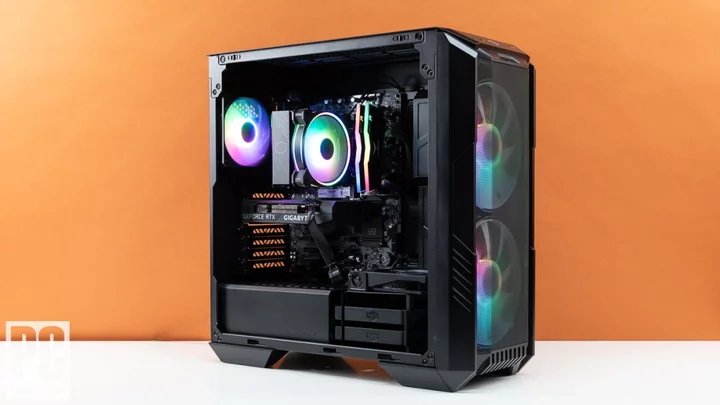Famed for aftermarket PC components, Cooler Master now produces its own line of gaming desktops. The HAF 5 Pro mid-tower reviewed here is its most budget-friendly option yet, starting at $1,199.99 for our review configuration with an Intel Core i5 CPU and Nvidia GeForce RTX 3060 Ti. There's lots to like about it, especially Cooler Master's attractive case and aftermarket-class build quality, and the fact that it builds and supports these towers in the United States. Though it doesn't replace the NZXT Player: One as our favorite economy gaming PC, this Cooler Master is a worthy alternative.
Old Wine in a Deluxe Bottle
The HAF 5 Pro starts with Cooler Master's iconic HAF 500 case, measuring 20.1 by 8.8 by 20.3 inches (HWD). It's on the large side for a mid-tower chassis and easily capable of holding much more powerful components than those installed here.
(Credit: Joseph Maldonado)Two huge 200mm fans provide ample air intake with minimal noise; they're joined by a 120mm rear exhaust and another 120mm fan on the Cooler Master Hyper 212 Halo Black CPU cooler. All the fans support ARGB lighting, though Cooler Master doesn't preinstall any software to control the lighting. Instead, a button on the front of the tower toggles through preset lighting patterns.
(Credit: Joseph Maldonado)Front-panel connectivity includes a pair of 5Gbps USB Type-A ports, one 10Gbps USB-C port, and a 3.5mm headphone/microphone jack. The power button is shaped like Cooler Master's logo.
(Credit: Joseph Maldonado)The many ports on the Gigabyte B760 DS3H AC motherboard include one 20Gbps USB-C, one 10Gbps USB-A, four USB 2.0, one Gigabit Ethernet, and three audio jacks (line-in, line-out, and microphone). The motherboard HDMI and DisplayPort connectors are disabled because the Core i5-12400F processor lacks onboard graphics. The Gigabyte-brand GeForce RTX 3060 Ti graphics card has two DisplayPort and two HDMI connectors.
(Credit: Joseph Maldonado)Undoing two thumbscrews lets you remove the left side panel. The blacked-out interior provides plenty of working space and, as mentioned, room for much larger components, including a 410mm graphics card and 360mm front- or top-mounted liquid-cooling radiators. There are also two 3.5-inch drive bays in the power supply compartment. The 600-watt Cooler Master G600 isn't a modular PSU, but its cables are neatly bundled.
(Credit: Joseph Maldonado)The 12-by-9.6-inch Gigabyte ATX motherboard provides two M.2 PCI Express 4.0 solid-state drive slots, four DDR4 memory slots allowing up to 128GB of RAM, and five expansion slots (one PCIe 4.0 x16 and four PCIe x16 running at x1). It's a basic board and doesn't support CPU overclocking. (The Core i5-12400F isn't unlocked, anyway.) For unfathomable reasons, the motherboard's built-in wireless is an outdated chip—think Wi-Fi 5 and Bluetooth 4.2—that isn't upgradable, so you'll have to install an aftermarket card in one of the expansion slots for faster wireless. The 1TB M.2 SSD in our review unit was also an older PCIe 3.0 drive.
(Credit: Joseph Maldonado)The HAF 5 Pro comes with Cooler Master's Devastator 3 USB keyboard-and-mouse combo, which is about $60 at retail and much better than the generic peripherals often bundled with desktops (if any are included at all, that is). The keyboard's rubbery keystrokes feel overly cushioned but are very quiet. It offers seven backlighting colors and variable brightness, all controlled via keyboard shortcuts since there is no companion app. The keyboard also has dedicated media playback and volume controls.
The optical mouse appears ambidextrous but is built for righties; its side buttons are on the left. Its main buttons have a generic feel; a DPI toggle behind the mouse wheel switches among four resolution presets.
(Credit: Joseph Maldonado)Preloaded software is minimal; even the usual bundled Windows 11 apps are absent, which is a good thing. Cooler Master covers the tower with a one-year warranty.
Testing the HAF 5 Pro: Solid Gaming Power
Priced at $1,199.99 MSRP but on sale for $1,099.99 at this writing, our HAF 5 Pro configuration combined a six-core Intel Core i5-12400F processor (2.5GHz base, 4.4GHz turbo), a GeForce RTX 3060 Ti graphics card, 16GB of DDR4 RAM, and a 1TB SSD. An $1,199.99 model (on sale from its $1,399.99 MSRP) bumps the CPU to a Core i7-12700F, while the top of the line offers a GeForce RTX 3070 GPU for $1,299.99 (down from an MSRP of $1,499.99).
These setups offer ample performance for today's AAA titles, but both the CPUs and graphics cards are previous-generation silicon, as are our test unit's PCIe Gen 3 SSD and Wi-Fi 5. NZXT also uses a Core i5-12400F in its Player: One, which includes a superior GeForce RTX 4060 Ti and Wi-Fi 6E for just $100 more. Otherwise, Cooler Master's pricing seems on target for a Core i5/RTX 3060 Ti desktop, as most similar models I saw at Best Buy were about the same price.
The desktops we're comparing the HAF 5 Pro's performance to include the Lenovo Legion Tower 5i Gen 8, which teams a GeForce RTX 3060 card with a newer Core i5-13400F CPU, and the NZXT Player: One which we tested with a GeForce RTX 3050 (the company has since upgraded its base graphics card to the RTX 3060). The remaining contenders are the Dell XPS Desktop (8950), with a GeForce RTX 3060 Ti, and the enthusiast-oriented iBuyPower Gaming RDY Y40BG202 to show the performance you can get by going two tiers up with its GeForce RTX 4070 Ti.
Productivity and Content Creation Tests
We run the same general productivity benchmarks across both mobile and desktop systems. Our first test is UL's PCMark 10, which simulates a variety of real-world productivity and office workflows to measure overall system performance and also includes a storage subtest for the primary drive.
Our other three benchmarks focus on the CPU, using all available cores and threads, to rate a PC's suitability for processor-intensive workloads. Maxon's Cinebench R23 uses that company's Cinema 4D engine to render a complex scene, while Geekbench 5.4 Pro from Primate Labs simulates popular apps ranging from PDF rendering and speech recognition to machine learning. Finally, we use the open-source video transcoder HandBrake 1.4 to convert a 12-minute video clip from 4K to 1080p resolution (lower times are better).
Finally, we run PugetBench for Photoshop by workstation maker Puget Systems, which uses the Creative Cloud version 22 of Adobe's famous image editor to rate a PC's performance for content creation and multimedia applications. It's an automated extension that executes a variety of general and GPU-accelerated Photoshop tasks ranging from opening, rotating, resizing, and saving an image to applying masks, gradient fills, and filters.
The HAF 5 Pro began with a 7,289-point showing in PCMark, just edging out the Lenovo Legion but trailing the Dell XPS. It also scored reasonably well in the storage test despite its older SSD.
The CPU results are intriguing because the HAF 5 Pro squeezes a lot of performance out of its Core i5-12400F, far outpacing the same chip in the NZXT. The Legion's newer Core i5-13400F has six Performance cores like the Core i5-12400F but also has four Efficient cores, so it should have been faster, but the HAF 5 Pro performed almost as well even in the longer-running HandBrake and Cinebench tests. This suggests the Cooler Master's CPU cooling is more effective.
Graphics and Gaming Tests
For gaming desktops, we run both synthetic and real-world gaming benchmarks. The former include two DirectX 12 gaming simulations from UL's 3DMark, the more modest Night Raid (suitable for systems with integrated graphics) and more demanding Time Spy (suitable for gaming rigs with discrete GPUs). Also looped into this battery of tests are two OpenGL exercises from the cross-platform GPU benchmark GFXBench 5, rendered offscreen to allow for different native display resolutions; more frames per second (fps) means higher performance.
Our actual gaming benchmarks are those built into F1 2021, Assassin's Creed Valhalla, and Rainbow Six Siege, representing simulation, open-world action-adventure, and competitive/esports shooter games respectively. We run Valhalla and Siege twice each at Ultra quality (at both 1080p and 4K resolution), while F1 is run at 4K only with and without Nvidia's performance-boosting DLSS anti-aliasing.
The HAF 5 Pro's GeForce RTX 3060 Ti is ideal for 1080p and 1440p gaming, but 4K play is a stretch. The Cooler Master matched the Dell (which uses the same GPU) in F1 2021, though it trailed in the CPU-sensitive Rainbow Six where the XPS's stronger Core i5-12600K took over. Both towers' frame rates in that game, however, were high enough that the difference is hard to appreciate. More significantly, the HAF 5 Pro's RTX 3060 Ti proved to be a clear step above the Lenovo's GeForce RTX 3060.
Verdict: Good Horsepower From Classic Engines
The Cooler Master HAF 5 Pro incorporates the company's top-quality components in a well-balanced build, offering excellent 1080p and 1440p gaming performance, quiet operation, and plenty of room for upgrades. Much of its hardware isn't the latest and greatest, but is perfectly usable. As we said, NZXT's Player: One still gets our nod for value—with Wi-Fi 6E and a newer GeForce RTX 4060 Ti card for $100 more—but if your budget's tight, the Cooler Master is a fine budget gaming tower. One thought, too, if you're comfortable with building your own PC, or you want to learn how: We put together a powerful desktop with the same Core i5 CPU and a superior GeForce RTX 4070 card for just a bit more money, at around $1,300. Check out our build guide if that idea piques your interest,









